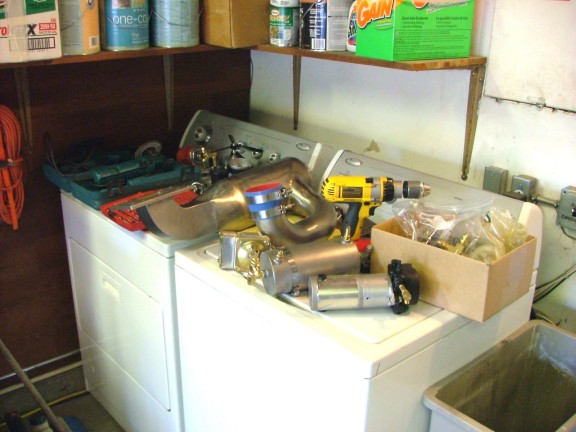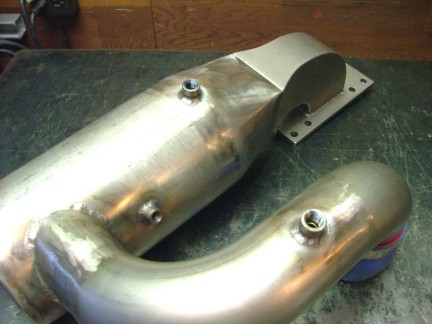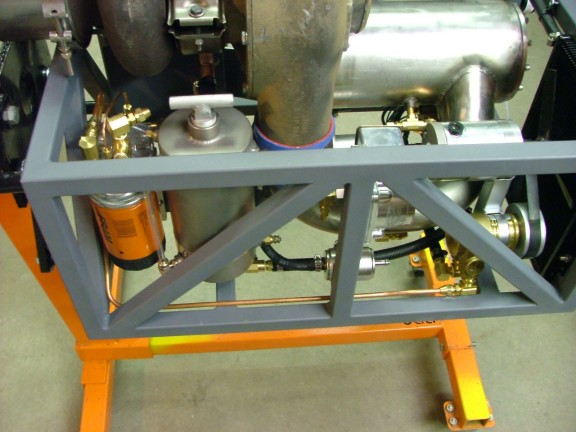|
|
 |
The fuel pump was the largest component to fit into the engine frame so I decided to install it first. Before I did anything, I prepared the fuel pump by disassembling it and painting the pump drive adaptor bracket. I also installed the newer rebuilt Webster eccentric gear pump to the assembly in leu of the older pump. With the ready to run assembly complete, I planned out it’s location in the engine frame. After weighing my options I settled on installing the pump just under the combustor and inlet duct.
|
 |
 |
|
I welded a cradle bracket to the bottom of the engine frame and test fit the pump assembly into it’s new home.
|
 |
 |
|
The ignition coil was next to be fitted so I fabbed up another cradle bracket and burned it on as well. I situated the coil near where I proposed my spark plug location would be on the combustor.
|
 |
 |
|
While working on the engine I noticed that a coat of rust was forming all over the frame. I did not want to have to sand blast the frame later on so I decided to strip the frame and get a coat of primer on it. I pulled all of the parts off the engine and cleaned it for paint. Once the rust was removed, I sprayed on an automotive gray primer to stop any further rust issues
|
 |
 |
|
I had set some of the engine parts on the washer/dryer while the frame was being painted. My wife Stacy was trying to get some laundry done and kindly asked me to remove the “junk” from the machines which prompted me to write my first turbine joke:
“If your wife asks you to kindly remove the combustor from the washing machine so she can do the laundry, you might be a DIY turbine builder ;0)”
|
 |
|
|
 |
 |
 |
|
Before I bolted the combustor back into the engine frame I needed to install the combustor drain fittings. The combustor drains will insure that there is no standing fuel in the bottom of the combustor during startup. This will prevent a “hot start” in which wet fuel is blown through the hot turbine wheel causing the engine to spit fire and overheat. I needed to install two separate drains as my inlet duct would need one as well as the combustion chamber.
The combustion chamber was built with a slight incline to facilitate proper draining of fuel. This allowed me to install the drains at the “low” points. I welded in some 304 half couplings that will be used later to plumb the drain system. I also added the combustor pressure tap while I was at it. I tried to install it in a location that would have the least turbulent air flow for steady pressure measurements. You can see it just above the inlet diffuser.
|
 |
|
|
 |
 |
 |
|
The next step was to install a heat shield around where the combustor elbow fits into the frame. This should prevent any radiant heat from damaging any subsystems that are close to the elbow. To do this I installed a 16 gauge plate just under the elbow’s location. The heat shield will help protect the oil pressure switch which was the next component to install.
|
|
|
|
|
 |
 |
|
I had found a couple of nice pressure switches on eBay a while back. They are similar to the one I used on the GR-1 & GR-5A. The switches are made by Barksdale Controls (Part# E1H-H90) and feature a 3-90 PSI adjustable trip rating. You can just dial in the low oil pressure limit and go. They are a little bulky but absolutely bullet proof and reliable.
|
|
 |
 |
|
The next components to install were the fuel control solenoids. I stumbled onto these babies in another eBay auction. They are made by the Allenair Corp. (Part# X3CBX4B) and are rated for gasoline, diesel, propane, and fuel oils. The 12V 7-Watt solenoids are rated for 150 PSI and feature 3-way valving. I am using three solenoids for the basic operation of the turbine: two for fuel control and one for a combustor auto drain. I positioned the solenoids close to where the fuel will enter the combustor end plate.
|
 |
|
|
 |
|